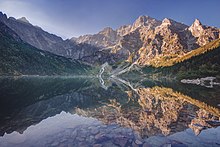
The Tatra National Park(Polish: Tatrzański Park Narodowy) is a national park in Poland. It is located in the southern part Lesser Poland, in the Tatra Mountains, he being both the Polish part of the High Tatras as well as the Western Tatras includes. With 3.3 million visitors a year, it is the most visited national park in Poland.
background



history
The park was designated as early as 1954.
landscape
The national park is 211.64 km².
Flora and fauna
It accommodates the steps of the lower and upper high forest, the Krummholzzone, the grassland up to the alpine rock step where chamois, marmots, brown bears, lynxes, wolves, otters, golden eagles, wallcreepers, brown alps, capercaillie, black grouse, hazel grouse, deer and roe deer Life. The chamois is the symbol of the national park.
climate
The weather in the national park is cool and rainy due to the high altitude on the northern slopes of the Tatra Mountains. Snow is guaranteed in winter.
getting there
Of Krakow buses and trains go to Zakopanewhere the administrative headquarters of the national park are located. You can also access the national park from Bukowina Tatrzańska, Poronin, Kościelisko or Chochołów explore. Minibuses circulate between the entrances to the national park and the center of Zakopane.
Fees / permits
There is a fee to enter the national park, tickets can also be purchased online on the park's website.
Day tickets cost online:
- Normal: 5 zloty (approx. EUR 1.20)
- Reduced: 2.50 zloty (approx. EUR 0.60)
Entry is free for:
- Children under 7 years
- People who are present for research purposes
- Schoolchildren and students who visit the park for didactic reasons
- Inhabitants of the municipalities in the national park
- People attending religious places of worship in the park
- People who are part of an extended family
Pay reduced admission
- pupils and students
- pensioner
- Disabled person
- Soldiers on active duty
mobility
You can hike and climb in the park along the hiking trails. Most mountains and passes can be climbed without any climbing knowledge, others - especially in the High Tatras, like the Eagle Walk or the way to the Meeraugspitze - require surefootedness. The rock faces and routes off the designated hiking trails require very good climbing skills and a permit from the national park administration. On the Kasprowy Wierch you can also take the cable car. Horse-drawn carriages and electric vehicles also take tourists to Meerauge and some valleys of the Western Tatras.
Tourist Attractions
- numerous mountain peaks and passes.
- numerous mountain lakes, especially in the High Tatras
- numerous caves, especially in the Western Tatras
activities
The national park is ideal for hiking and climbing. In the lower areas you can also go well with the mountain bike.
shop
At the entrances and the mountain huts you can buy souvenirs, maps and postcards as well as small snacks.
accommodation
There are seven mountain huts and one mountain hotel in the park (Kalatówki Mountain Hotel) of Polish Alpine Club (Chochołowska Hut, Kondratowa Hut, Meerauge Hut, Murowaniec hut, Ornak hut, Five Polish Lakes Hut and Roztoka Hut) and numerous hotels, guest houses, guest rooms and hostels in all the surrounding villages. You can also spend the night on campsites and tent sites.
security
Rock falls pose the greatest risk in the park. If you want to climb, you should pay attention to adequate protection. Appropriate and weatherproof clothing and sturdy shoes are necessary, unless you just stay in the valleys or let yourself be chauffeured to selected destinations by cable car or horse-drawn carriage. A descent from Kasprowy Wierch is possible in winter. The slope should not be left here due to the risk of avalanches. There are wild animals such as brown bears and wolves in the national park. However, these mostly remain in the valleys of the Tatra Mountains, which are closed to tourism, for example in Waksmund Valley. You shouldn't enter these valleys either. Should you still encounter a bear, you should keep calm. Under no circumstances should one provoke bears with cubs, e.g. throw stones at them. As a rule, the shy animals will run away themselves or ignore people.
literature
See article too Poland.
Web links
- http://www.tpn.pl/ - Official website of the Tatra National Park



